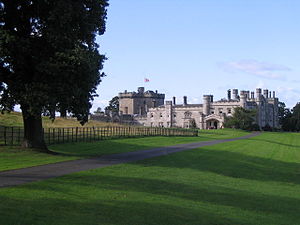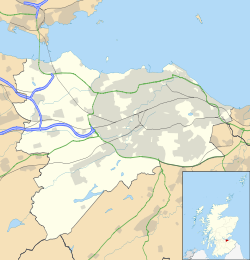Dundas Castle
| Dundas Castle | |
|---|---|
| Edinburgh, Scotland | |

Dundas Castle
|
|
| Coordinates | Lua error in package.lua at line 80: module 'strict' not found. |
| Site history | |
| Built | 15th century |
Dundas Castle is a 15th century castle, with substantial 19th century additions by William Burn, in the Dalmeny parish of West Lothian, Scotland. The home of the Dundas family since the Middle Ages, it was sold in 1899 to the Clark family, and is currently the residence of Sir John 'Jack' Stewart-Clark.
History
The name Dundas comes from the Gaelic dùn deas, meaning 'south hill' or 'pretty hill'.[1] In the 11th century, the lands of Dundas, along with several other lands in Lothian, were granted by King Malcolm Canmore to Gospatric, the earl of Northumbria, who had come north to escape William the Conqueror. The lands of Dundas passed to his great-grandson Waldeve, who granted them to Helias son of Uchtred in a charter dating from around 1180. The precise relation between Waldeve and Helias is not known, but they were undoubtedly kinsmen.[2] Helias took his surname from his lands, becoming the first of the Dundas family. The Dundases of that Ilk and their cadets would later come to control much of Mid and West Lothian.[3]
In 1416, James Dundas obtained a licence from the Duke of Albany (then the effective ruler of Scotland) to build a keep. This keep was extended in 1436, making it into an L-plan. The Keep served both as a home in times of peace and a fortress in times of war. Oliver Cromwell is known to have stayed at Dundas Castle around the time of the Battle of Dunbar in 1650. A statue of him remains standing outside the Keep.[4]
In 1818, James Dundas had the 17th century portion of the building pulled down and rebuilt in a Tudor-Gothic style by the renowned architect William Burn.[3] Burn also designed many churches and this influence is visible throughout the building. Burn's designs for the main state rooms allow for huge windows that look out on to lawns and parkland outside.
The building and extensive gardens had cost so much to construct that the Dundases were forced to sell the castle and lands in 1875. The buyer was William Russell.[5] It was again sold in 1899, when it was bought along with five farms and 1,500 acres (6.1 km2) of agricultural land by Stewart Clark, the owner of a Renfrewshire textile company and a respected philanthropist. Clark's son, John, took the double-barrelled surname 'Stewart-Clark' in honour of his father, and was made a Baronet in 1918.
During the Second World War, Dundas Castle served as the headquarters for protecting the Forth Bridge. Since 1995, the castle's owner has been Sir Jack Stewart-Clark, the great-grandson of Stewart Clark. Stewart-Clark was a Member of the European Parliament between 1979 and 1999.[6]
Facilities
By the time Sir Jack inherited the property from his mother in 1995, it had deteriorated substantially. He initially considered selling it, but instead chose to embark on a programme of restoration. The Keep, uninhabited for over 300 years, had its parapet rebuilt and its stonework restored, and was installed with electricity, heating, toilets and a kitchen. The dry rot in the castle itself was removed, and the drawing room, library and dining room were redecorated. The castle is now a 5 star exclusive venue, often used for weddings.[7]
In the grounds of the Castle is a holiday cottage called the Boathouse, situated on the shore of Dundas Loch. It is a 4 star-self catering venue.
Dundas Castle is a member of Unique Venues of Edinburgh[8] and Luxury Edinburgh[9]
Film and TV location
Dundas Castle has been used as a backdrop in films The Little Vampire (2000), Summer Solstice (2005), and Book of Blood (2009). It has also been used for adverts for Arnold Clark and T4’s links between shows.
Gallery
-
MA(1829) p.316 - Dundas Castle - John Preston Neale.jpg
1829 drawing by Thomas Shepherd
-
The Honeymoon Suite - geograph.org.uk - 543908.jpg
The Boathouse
-
Dundas Loch - geograph.org.uk - 543903.jpg
Another view of the loch
-
Parkland, Dundas Castle. - geograph.org.uk - 44285.jpg
Part of the grounds
-
Dundas Castle Estate - geograph.org.uk - 543831.jpg
Entrance to the estate
-
Wheatfield, Westfield Farm. - geograph.org.uk - 44287.jpg
The edge of the estate, with the Forth Road Bridge in the background
References
- ↑ Lua error in package.lua at line 80: module 'strict' not found.
- ↑ Lua error in package.lua at line 80: module 'strict' not found.
- ↑ 3.0 3.1 Lua error in package.lua at line 80: module 'strict' not found.
- ↑ Lua error in package.lua at line 80: module 'strict' not found.
- ↑ Lua error in package.lua at line 80: module 'strict' not found.
- ↑ Lua error in package.lua at line 80: module 'strict' not found.
- ↑ Lua error in package.lua at line 80: module 'strict' not found.
- ↑ Lua error in package.lua at line 80: module 'strict' not found.
- ↑ Lua error in package.lua at line 80: module 'strict' not found.
External links
Lua error in package.lua at line 80: module 'strict' not found.
